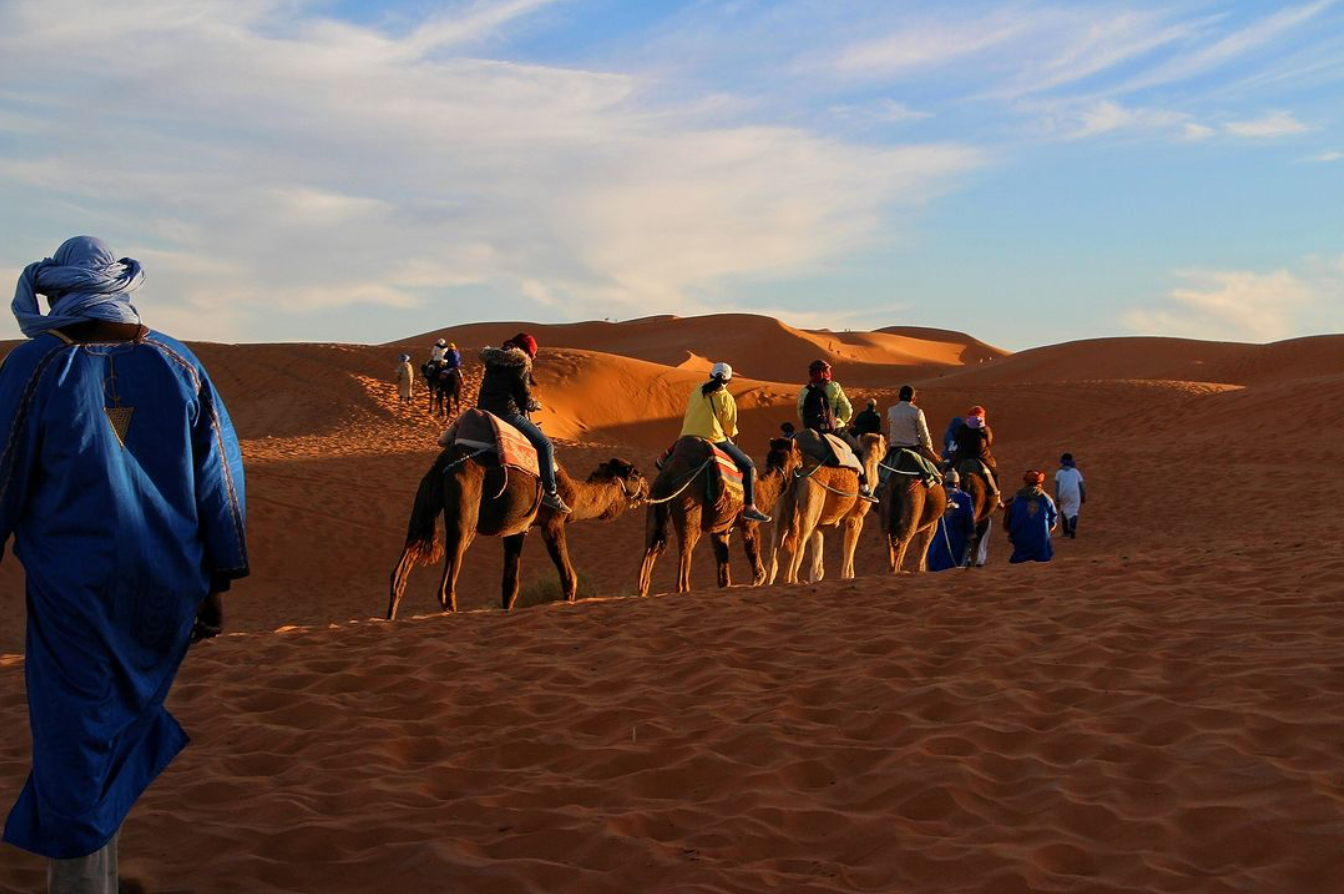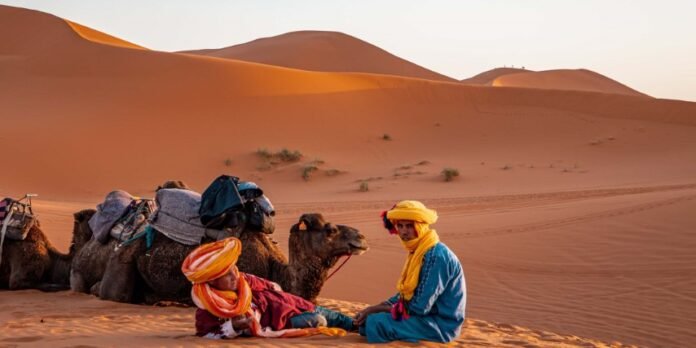Introduction
Walking through the souks of Marrakech or Fez, amongst the labyrinth of alleyways filled with shops selling spices, leather goods, and gleaming handicrafts, it’s easy to feel transported back in time. These medinas’ sights, sounds, and smells glimpse Morocco’s rich history and diverse cultural heritage. However, beyond the impressions of this vivid sensory tapestry lies a deeper cultural thread that remains less visible to outsiders – the Berber languages indigenous to North Africa that weave through the peoples and places of this captivating nation.
As a native English speaker visiting Morocco, Arabic instantly stands out as the dominant verbal language encountered. Yet estimates indicate that around 30-50% of Moroccans claim some level of Berber ancestral descent. So, who are the Berbers, and what importance do their native tongues hold within Morocco’s cultural identity? In this article, I hope to explore the Berber languages that remain overlooked despite endemic roots across Morocco, Algeria, and parts of the Western Sahara. We can help foster greater cross-cultural understanding and advocate for their ongoing preservation by highlighting these oral traditions.
Origins and Variation Across North Africa
To begin contextualizing the Berber languages, tracing their origins across the North African region is advantageous. Linguistic studies indicate that Berber populations have inhabited this area for at least 8,000 years, with the earliest archeological evidence of settlements found in Morocco dating back around 12,000 years. Genetic research further reinforces that Berber ancestry connects strongly to the prehistoric inhabitants of North Africa.
Despite sharing common linguistic precursors, the Berber languages today encompass a variety of distinct yet mutually intelligible forms across the Maghreb states of Morocco, Algeria, Tunisia, Libya, and parts of Mali, Niger, and Burkina Faso to the south. Numerous Berber languages exist in Morocco, including Tamazight, Tashelhit, Tarifit, Taqbaylit, and Tachelhit. Variation occurs between countries and amongst different tribal groups within similar geographical regions depending on prolonged isolation or language shifts over time.
This diversity can make categorization challenging, yet linguists generally organize Moroccan Berber into three main branches – Tashelhit, Tarifit, and Central Moroccan Tamazight. For instance, Tashelhit notably spread through southern Morocco and small enclaves in Western Sahara, while coastal Jebli and Rifian speech communities in the north fall under Tarifit, despite disparities, standard phonemic, morphological, and syntactic features that distinctly separate Berber from other nearby Afroasiatic languages like Arabic or Hausa endure.
A Living Oral Tradition
What stands out most about Berber tongues is their foundation as primarily oral vernaculars passed down through the generations without a fixed written script. While Arabic became the written liturgical language following Islamic expansion, Berber communities maintained their daily speech independently from outside influences. Even today, an estimated 90% of Berber speakers rely on oral transmission to sustain their languages, according to UNESCO data.
This oral tradition means Berber vocabulary, grammar, and pronunciation are naturally adapted to each local speech community over time. Dialectal differences multiplied the farther apart populations dispersed geographically from one another. However, the lack of standardized writing also made Berber languages more vulnerable to language shift towards the prestige of Arabic. With each subsequent generation, fewer native Berber speakers emerged, threatening their intergenerational transmission.
Fortunately, grassroots movements emerged in the 20th century advocating for Berber linguistic, cultural, and political rights – most notably the famous Amazigh Spring protests of the 1980s. Such activism spurred the Moroccan government to officially recognize Berber as an integral part of the nation’s heritage in its 2011 constitution. This landmark acknowledgment represented progress defending Berber’s cultural patrimony and language vitality. Still, a long road lies ahead to strengthen Berber’s presence and promote revitalization efforts across diverse Amazigh-home communities.
Preserving Cultural Heritage
With Berber languages facing ongoing endangerment, how can their preservation best be supported moving forward? Several proactive steps that go beyond surface-level acknowledgment deserve consideration.
First, developing standardized writing systems could boost literacy while protecting against language shifts. Now, Moroccan Berber educators devised orthographies based on the Latin and Arabic scripts for teaching Tamazight. Extending their use promotes accessibility and documentation critical for vulnerable oral traditions.
Secondly, increasing the domains where Berber is employed counters historical marginalization. Instituting it within schools, government offices, signage, and media outlets enhances visibility and intergenerational transmission—countries like Algeria spearhead such “domain expansion” to strengthen indigenous community language resilience.
Community-led initiatives also revitalize Berber at the grassroots level. Cultural centers teach traditional music, dance, crafts, and oral histories in native Berber. Summer language immersion programs similarly immerse youth in authentic language learning environments. These experiences foster pride in Amazigh heritage while attracting new learners.
Lastly, advancing linguistics research helps document Berber variation before it disappears. Projects archive recordings of older speakers to build authoritative dictionaries analyzing vocabulary, sounds, and grammatical structures. They also train new generations of scholars committed to describing Berber’s rich linguistic tapestry and advocating for its social importance within Morocco’s identity.
By combining these strategies, Amazigh communities and their supporters can actively work to shift Berber languages from endangered to thriving once more. Their unique cultural contributions can endure for ages with continued dedication and cooperation across different sectors.

Exploring Berber Diversity in Morocco
To better understand Berber’s living role in Morocco today, exploring some of its diverse regional forms across the country is instructive. Three main areas exemplify the variations that make up this underrecognized linguistic landscape.
Tashelhit in the Souss Valley
One of Morocco’s most widely spoken Berber languages reaches across the Souss Valley, stretching southwest from Agadir towards the Western Sahara border. Referred to as Tashelhit by its native speakers, this Southern Berber dialect shares core features with other Afroasiatic tongues, like gendered nouns and complex verb conjugations. However, its distinct phonology and vocabulary also set it apart.
Tashelhit serves as the primary community language in the valley with an estimated million speakers, though bilingualism in Arabic remains prevalent in urban centers. Traditional lifestyles center around oasis agriculture, producing olives, almonds, and dates using irrigation systems passed down for generations. Tashelhit naturally pervades these rich cultural domains associated with land stewardship, crafts, cuisine, and folktales.
Venturing into rural Souss villages provides the best opportunities for encountering Tashelhit in its natural habitat. Families proudly continue transmitting it to children despite lacking official school support until recently. Grassroots cultural centers celebrate Tashelhit heritage through music, dance workshops, and oral storytelling performances – a testament to community resilience, preserving Amazigh roots amidst urbanization pressures. Overall, the region is a stronghold, keeping Tashelhit vital through unbroken intergenerational transmission.
Rif Berber Along the Mediterranean
Another concentrated Berber zone exists along Morocco’s northern Mediterranean coast within the Rif mountainous region. Three main Rif Berber dialects include Tarifit, Shilha, and Tarifit, semi-distinct oral varieties showcasing historical differentiation. Their speakers, known as Riffians, traditionally relied on subsistence farming, fishing, crafts, and trade for livelihoods, maintaining close clan ties within remote communities.
While linguistic differences exist between these Rif Berber forms, shared phonetic shifts from Standard Moroccan Tamazight create clear regional boundaries. For instance, Tarifit transitions /q/ to /g/, resulting in lexical items like “good morning” becoming ziggurat n dad instead of standard aqqim n dad. Phonemic divergence paired with waves of migration propagated variations across Rif society over the centuries.
Today, the Rif remains linguistically and culturally vibrant as its people pursue revitalization through Rap music, women’s cooperatives, and agricultural cooperatives alongside Spain. With Spain’s North African exclaves just miles across the Strait of Gibraltar, Rif Berber also retains cross-border sociolinguistic ties with descendant populations. Overall, the Rif is a proud cultural hub where Berber roots took divergent phonological paths while persisting amongst similar landscapes.
Tamazight Across Central Morocco
Considered the prototypical or “Standard” Moroccan Berber, Tamazight originated in mountainous regions of the Middle and High Atlas ranges, spreading eastward. While facing increasing language shifts in urban cores, rural Tamazight-speaking zones maintain the language as a critical component of traditional identity.
One such stronghold exists north of Marrakech within the Ait Bou Guemez valley, where picturesque stone villages dot the landscape under towering snowcapped peaks. Here, families raise goats and cultivate crops according to practices undisturbed for generations. Women craft distinctive Berber carpets and weavings dyed with natural pigments that visually capture Amazigh cultural symbolism.
Standardization Efforts
One of the biggest challenges for Berber languages has been the lack of standardization due to their mainly oral traditions. In recent decades, linguists and educators have worked to develop written forms to increase literacy and formal use. For example, Moroccan Tamazight now has two standardized orthographies – Tifinagh, the ancient Berber script, and a Latin-based version. Both are being taught in Berber-medium schools with grammar books and dictionaries published. Other languages like Tashelhit are following suit. Standardization allows Berber to be used more officially while preserving variations. It strengthens revitalization by expanding domains of use.
Sociolinguistic Context
While Moroccan Berber languages share common origins and structure, regional differences exist due to the long isolation of mountain communities. Variation is also tied to social factors like gender, occupation, and generation. Younger urban Berbers often code-switch between Berber and Arabic fluidly. In rural areas, men typically have more robust Berber proficiency due to traditional roles. Occupational domains also influence use – shepherds maintain the language more than merchants exposed to Arabic. Understanding these sociolinguistic contexts is critical for educational materials and language policies to include diverse needs.


